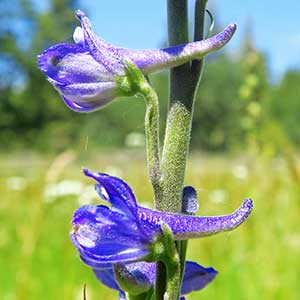Delphinium distichum
Delphinium alabamicum
Burke's larkspur, meadow larkspur, strict larkspur, two-spike larkspur
Alabama larkspur
(25-)30-60(-80) cm;
base sometimes reddish, puberulent.
(45-)60-90(-130) cm;
base reddish, pubescent.
blade cuneate to semicircular, 1-5 × 1.5-7 cm, puberulent; ultimate lobes 5-19, width 2-8(-15) mm (basal), 0.5-3(-5) mm (cauline);
margins of basal leaf, measured less than 1 cm from blade base, demarcating considerably more than 90° of arc when leaf laid flat;
most cauline leaf blades exceeding internodes.
blade reniform to semicircular, 2-11 × 3-19 cm, nearly glabrous; ultimate lobes 3-35, width 3-8 mm (basal), 0.5-3 mm (cauline), widest at middle or in proximal 1/2.
8-30(-40)-flowered, usually dense;
pedicel 0.5-1.5 cm, puberulent;
bracteoles 0-3 mm from flowers, green to blue, linear, 4-8 mm, puberulent.
5-27-flowered;
pedicel 1-5 cm, puberulent;
bracteoles 3-12 mm from flowers, green, linear, 2-8 mm, puberulent.
sepals dark blue to bluish purple, puberulent, lateral sepals ± erect, 8-12 × 3.5-5 mm, spurs straight, horizontal or nearly so, 9-15 mm;
lower petal blades ± covering stamens, 4.5-6.5 mm, clefts 2-3 mm;
hairs centered mostly near base of cleft, white.
sepals royal blue, ± drab, often partly fading upon drying, puberulent, lateral sepals spreading, 12-20 × 5-10 mm, spurs straight, horizontal to slightly ascending, (13-)15-16.5(-19) mm;
lower petal blades ± covering reproductive parts, 4-10 mm, clefts 3-5 mm;
hairs centered between claw and base of cleft, covering most of adaxial surface, white.
7-13 mm, 3.5-4 times longer than wide, ± puberulent.
11-18 mm, 2.5-3 times longer than wide, sparsely puberulent.
seed coat cells with surfaces roughened.
unwinged;
surface of each seed coat cell with with swollen, blunt, hairlike structures, barely visible at 20x, otherwise smooth.
= 16.
= 16.
Delphinium distichum
Delphinium alabamicum
Delphinium distichum hybridizes with D. multiplex and D. nuttallianum (D. ×diversicolor Rydberg). The name D. burkei has often been misapplied to D. distichum.
(Discussion copyrighted by Flora of North America; reprinted with permission.)
Of conservation concern.
In addition to the Alabama sites, Delphinium alabamicum is known from one population in Georgia; it might have been transplanted there. Delphinium alabamicum has not been seen in central Alabama since 1950; populations there might have been extirpated.
(Discussion copyrighted by Flora of North America; reprinted with permission.)
- Local floras:
BC,
OR,
WA
- Local Web sites:
Flora NW,
PNW Herbaria
WildflowerSearch
iNaturalist (observations)
USDA Plants Database
- LBJ Wildflower Center
- SEINet
- Plants of the World Online
- Encyclopedia of Life
- Wikipedia
- Google Image Search


